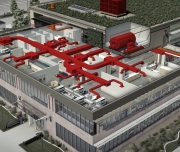System Overview
Heating, ventilation, and air conditioning (HVAC) systems are responsible for providing thermal comfort and fresh air to building occupants. This is no small task, and as a result, HVAC systems consume an average of 39% of a facility’s energy use.1 These systems are often some of the biggest sources of energy waste, but also provide some of the largest opportunities for both energy and financial savings.
Many improvements to HVAC energy efficiency are among the “low hanging fruit” and can be achieved at little or no cost. Larger projects can also pay for themselves quickly. These improvements make striking a balance between comfort and efficiency easy, and help ensure:
- Worker productivity
- Occupant satisfaction
- Personal health
- Lower operating costs throughout the life cycle of the facility
- Reduced risk exposure to fluctuating energy prices
HVAC Components
- Facility-Wide
- Mechanical Room
1 Source: Whole Building Design Guide

